Before the Gold Rush changed California forever, and before California became a state, Fort Ross was a windswept outpost where Russian settlers and fur traders built a rugged community along the Sonoma Coast from 1812 to 1841.
On Thursday, a Bay Area environmental group announced the latest chapter at the venerable landscape: a $15 million deal to purchase 1,624 acres of redwoods and picturesque coastal meadows adjacent to what is now Fort Ross State Historic Park, expanding the protected lands around the site by 50%.
The redwoods property, larger than Golden Gate Park in San Francisco, includes 3.2 miles along Highway 1 that could have been developed into luxury homes.
Every year thousands of tourists, schoolchildren and others visit the historic wooden buildings at Fort Ross, and the purchase by the non-profit group Save the Redwoods League from Soper Wheeler timber company guarantees that rural part of the North Bay coast will remain as scenic open space, looking for generations to come much the same as it did 200 years ago.
“This property feels like the very best of California,” said Sam Hodder, president of Save the Redwoods League. “It’s true California coastline. It has spectacular redwood groves, sweeping vistas of the Pacific shoreline, and classic coastal bluffs with fingers of redwood forests coming up the drainages. It is just a stunning landscape.”
Save the Redwoods League, founded in 1918, has protected more than 220,000 acres of redwood and sequoia forests over the last century. By buying land and development rights from willing sellers, it has expanded 66 state, national and local parks around California, including Redwood National Park and Sequoia-Kings Canyon National Park, along with Big Basin, Calaveras Big Trees, Del Norte, Emerald Bay, Grizzly Creek, Año Nuevo, Henry Cowell, Prairie Creek, Pfeiffer Big Sur, Jedediah Smith and other landmark state parks.

In 1989, the league purchased 2,157 acres adjacent to Fort Ross and sold it to California’s state parks department below the appraised price, expanding Fort Ross state park to 3,393 acres.
Hodder said the organization has been in discussion with state parks officials, along with Sonoma County parks officials, about selling the property in the coming years to allow public access and expanded recreation along the California Coastal Trail through the area.
The administrations of former Gov Jerry Brown and Gov. Gavin Newsom have resisted expanding the state parks system, citing budget constraints. Their two administrations have established only one new state park since 2009, Dos Rios State Park, which opened in June, and is 8 miles west of Modesto near the confluence of the San Joaquin and Tuolumne rivers.
“We’re trying to map out the strongest possible conservation outcome,” Hodder said of the newly purchased Sonoma Coast property. “It would be a terrific addition to Fort Ross state park.”
That may depend, he said, on voters passing Proposition 4, a $10 billion climate bond on the November state ballot that contains funding for parkland acquisition.
The property, inhabited for generations by the Kashia Band of Pomo Indians, is believed to be the first in California where redwoods were logged by Europeans, when crews working for John Sutter, the pioneer who purchased Fort Ross in the 1840s area after the Russian outpost declined.
It has some of the largest second-growth redwoods in California, towering 220 feet or more, along with several remaining old-growth redwoods estimated to be at least 1,000 years old.
Since 1980, it has been owned by Soper Wheeler timber company. Founded in 1904 and based in Nevada City, the company has been selling off its land holdings in recent years, said Aric Starck, executive chairman of its board.

It is owned by about 90 shareholders around the country, many of whom are direct descendants of founders James P. Soper Jr. and Nelson P. Wheeler. With California’s tough environmental rules and competition from other large timber companies, the shareholders decided it was time to move on, he said.
The company has sold much of its roughly 200,000 acres to Sierra Pacific and other timber companies. It is looking to sell 16,000 acres in other parts of Sonoma County, in Bonny Doon in the Santa Cruz Mountains and in other areas, Starck said.
“This property is a marquee piece,” Starck said. “It’s timberlands and beautiful coastal land. It would be great if it went to state parks and had a public use. That would be a fabulous outcome.”
Three years ago, the company sold 3,181 acres of rugged coastal redwoods along the Lost Coast in Humboldt County to Save the Redwoods League for $36.9 million.
“We’ve always practiced sustainable forestry,” Starck said. “We love what Save the Redwoods League is doing.”
Some of the Sonoma County property burned in 2020 during a wildfire. But much of the damage was moderate, and the forests already are recovering, Hodder and Starck said. The company planted 105,000 redwood seedlings on it over the past several years, working with Save the Redwoods League.
Caryl Hart, a Sebastopol resident and chairwoman of the California Coastal Commission, said she also would like to see the land added to Fort Ross State Historic Park.
“It’s a fantastic deal,” said Hart, a former director of Sonoma County Regional Parks. “It’s exactly what we should be doing — protecting these coastal areas that have been owned by timber companies and providing access eventually to the public. It’s a big deal. The preservation of this land is so important.”

